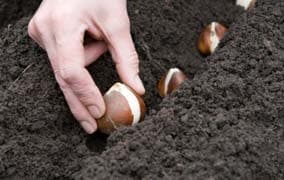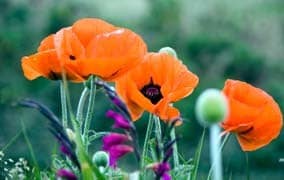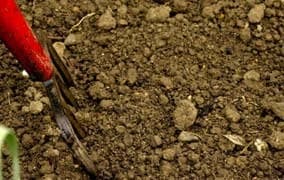Dividing overcrowded pond plants. Remove and divide large and overgrown aquatic plants.
Plant out tender perennials
Half-hardy and tender plants can be safely planted out after the last likely frost date in your area. Start hardening-off [link] plants a couple of weeks before planting out to get them acclimatised to the growing conditions outside. Rooted cuttings taken from tender perennials at the end of last season should be left for a few more weeks before planting them out.
Tools required. hand trowel
Skill rating. easy
Continue weeding
Make sure you dig up weeds before they flower and set seed. The easiest way to do this is to hoe between permanent plants when the weeds are still small. Hand weed around the emerging shoots of bulbs and herbaceous plants to prevent damage. Established perennial weeds, such as dandelion and dock need to be removed complete with their carrot-like tap-root. If digging is impractical, such as between groundcover plants, you could spot treat them with a glyphosate-based weedkiller such as a wipe-on chemical weeder or a ready-to-use spray.
Tools required. hoe, garden gloves, or a spot weedkiller
Skill rating. easy
Continue mowing
Adjust the cutting height of your mower to a height of 4cm (see manufacturer’s instructions). Cut the grass when it reaches about 6cm long. Do not use a grassbox on your mower unless the clippings are over 2cm long. Instead, leave the clippings as a mulch on the lawn to feed the grass. Trim the edges with edging shears to create a perfect finish.
Tools required. lawnmower, edging shears
Skill rating. easy
Plant up summer containers
After the last frost date [link to weather] plant up containers with tender flowering bedding and reliable foliage plants. Line terracotta pots with polythene, taking care not to cover the planting holes, to reduce water loss through the porous sides of the pot. This will mean the containers will need watering less often. Also add watering-retaining gel to the compost before planting. Push tablets of slow-release fertiliser into the compost after planting to feed the plants all summer long.
Tools required. container, compost, water-retaining gel, slow-release fertiliser
Skill rating. moderate
Keep cool
Greenhouse temperatures can rocket sky-high unless you take steps to control them. There are three methods you can use: ventilation, shading and damping down. Ventilating a greenhouse by opening and closing the windows by hand is almost a full-time job, so it makes sense to invest in an automatic vent opener to do the job for you. These can be fitted to hinged roof vents or louver vents in the walls of the greenhouse. It also worth applying shading to the greenhouse. Shading washes applied to the outside of the glass are probably the cheapest and most convenient, although internal shading fabric and external blinds are also worth considering. On hot days you can cool the atmosphere inside a greenhouse by damping down, that is by wetting surfaces such as the path and staging. When the water evaporates it absorbs energy and cools the greenhouse.
Tools required. greenhouse accessories
Skill rating moderate
Plant aquatics
Choose a sunny warm day to make the job more pleasant. Use a special aquatic basket with lattice-work sides to plant both marginals for the shallows around the edge of the pond and for deep-water plants such as waterlilies. It is also important to use special aquatic compost which releases nutrients slowly otherwise the pond water will turn green with algae. After planting, cover the surface of the compost with a 2cm layer of washed gravel which will prevent fish from stirring up the compost. Plunge each basket into a bucket of pond water until the air bubbles stop coming out of the compost. Then place the plant in the pond. Stand waterlilies on bricks so that their leaves are just below the surface. As the leaves grow, lower the basket in stages until it is sitting on the floor of the pond.
Tools required. aquatic basket, aquatic compost, gravel
Skill rating. moderate
Dividing aquatics
Carefully remove the overgrown plants from the pond and cut back any old foliage. Remove the basket or, if necessary, cut it from the plant’s roots using a pair of secateurs. Stand the rootball on a firm surface then break it up using your hands or slice it into sections with secateurs or a sharp spade making sure each section has plenty of roots and shoots or plump buds. Pot up the youngest most vigorous sections and give away or discard the rest.
Tools required. secateurs, aquatic basket, aquatic compost, gravel
Skill rating. moderate
Trim hedges
Fast-growing hedges such as privet, Lonicera nitida and laurustinus (Viburnum tinus) need to be trimmed every month throughout the growing season to keep looking neat and tidy. Also trim formal hedges of Escallonia.
Tools required. shears or hedgetrimmer
Skill rating. moderate
Tie in climbers
Check all climbers over to make sure they are secure tied to their supports and tie in any new extension growth as well as new shoots from the base. Help self-clinging climbers to locate their support by tying wayward shoots to the support.
Tools required. string and garden knife
Skill rating. easy
Water new plants
New plants need to be kept well watered throughout the first growing season if they are to establish quickly. Treat them like container plants in their first year and include them on your regular watering schedule.
Tools required. watering can or hosepipe
Skill rating easy
Feed container plants
Unless your incorporated a slow-release fertiliser into the compost at planting time, displays in pots will start running short of nutrients after about six weeks. Prevent this from happening by pushing in slow-release fertiliser pellets into the compost now or start feeding plants regularly using a liquid feed while watering. Use a high-potash liquid feed, such as tomato fertiliser or one specially formulated for flowering plants and bedding, to encourage more flowers.
Tools required slow-relase fertiliser tablets or a high-potash liquid feed
Skill rating easy
Bulbs in lawns
After about six weeks after flowers have faded the foliage of bulbs grown in grass can be cut back. Use a pair of shears for small areas or a nylon-line trimmer or a rotary mower with the blades set at their highest position (see manufacturer’s instructions). Reduce the height of the cut over the next few weeks until the area of naturalised bulbs can be trimmed at the same time as the rest of your lawn.
Tools required. shears or nylon-line trimmer
Skill rating. easy
Make sowings of vegetables
Many vegetables can be sown direct outside into a prepared seedbed this month. Continue to sow short rows of quick-maturing salad vegetables, such as lettuce and radish as well as carrots, beetroot and peas, for a continuous harvest throughout the summer months. See the seed packet for details of correct spacing for each crop. Make each sowing as soon as the previous sowing has emerged. Also in milder areas sow French beans and runner beans direct outside this month, spacing the seeds 15cm apart in the row.
Tools required. rake, hoe
Skill rating. moderate
Earth-up potatoes
Prevent frost from damaging susceptible growing tips of early and maincrop potatoes by piling soil on top of emerging shoots if frost threatens. This technique is known as earthing-up. If shoots are too long, protect them with a double layer of garden fleece on frosty nights.
Tools required hoe, garden fleece
Skill rating easy
Protect strawberries
Place straw, black polythene or special matting under strawberries to protect the fruit from getting spoilt by mud-splash. Scatter slug pellets along the rows to prevent slugs and snails and cover ripening fruit with bird-proof netting. Prevent birds feeding through the netting by making sure it is held well off the crop using wire hoops or short bamboo canes with upturned plastic pots on the end.
Tools required. strawberry matting, slug pellets, plastic bird-proof netting
Skill rating. easy
Water fruit crops
To get the best harvest of fruit keep crops well watered while the fruits are forming particularly if your garden soil is light and well drained. If they run short of water at this stage the young fruitlets are often shed. Pay particular attention to fruit crops in containers or trees planted against walls.
Tools required. watering can or hosepipe
Skill rating. easy
Plant greenhouse tomatoes and peppers
Space plants 35cm apart in the border or plant three per growing bag. Prepare border soil by digging in well-rotted organic matter and apply a balanced fertiliser such as growmore at the rate of 70g per square metre. Prepare growing bags by puffing them up like a pillow to loosen the compost, then cut holes as directed in the bag instructions. Water the plants in their pots before planting and firm the soil or compost around the rootball so that the plant is at the same depth as it was in the pot.
Put up supporting canes or strings hung from overhead wires. Push the canes into the soil/compost next to the plant and tie it to the overhead wire for security. Tie the string to the base of the plant using a non-slip knot, leaving plenty of space for the stem to expand as the plant grows.
Tools required. growmore, growing bag, canes
Skill rating. moderate
Greenhouse pest patrol
Aphids. Check the undersides of leaves and growing points of new shoots for clusters of sap-sucking aphids sap-sucking. Rub off small colonies between finger and thumb or apply a suitable insecticide spray.
Whitefly. Keep an eye open for the first signs of whitefly. They feed on the undersides of leaves and fly up in small clouds when disturbed. Yellow stick traps, sucking them up with a small car vacuum can be effective if the infestation is not too severe. Otherwise use a suitable contact insecticide.
Spider mites. If you notice cucumber or melon leaves that appear speckled, check the undersides of the leaves with a hand lens to see if you can spot the tiny mites that can cause this symptom. Remove badly affected leaves and mist the plants with water to increase humidity. Severe infestations can be controlled using a suitable systemic insecticide.
Tools required. Liquid malathion, Nature's Answer to Insect Pests, Natures Answer Flying Insect Traps
Skill rating. moderate
Plant up your pond
Choose a sunny warm day to make the job more pleasant. Use a special aquatic basket with lattice-work sides to plant both marginals for the shallows around the edge of the pond and for deep-water plants such as waterlilies. It is also important to use special aquatic compost which releases nutrients slowly otherwise the pond water will turn green with algae. After planting, cover the surface of the compost with a 2cm layer of washed gravel which will prevent fish from stirring up the compost. Plunge each basket into a bucket of pond water until the air bubbles stop coming out of the compost. Then place the plant in the pond. Stand waterlilies on bricks so that their leaves are just below the surface. As the leaves grow, lower the basket in stages until it is sitting on the floor of the pond.
Tools required. aquatic basket , aquatic compost, gravel
Skill rating. moderate
Dividing overcrowded pond plants
Carefully remove the overgrown plants from the pond and cut back any old foliage. Remove the basket or, if necessary, cut it from the plant’s roots using a pair of secateurs. Stand the rootball on a firm surface then break it up using your hands or slice it into sections with secateurs or a sharp spade making sure each section has plenty of roots and shoots or plump buds. Pot up the youngest most vigorous sections and give away or discard the rest.
Tools required. secateurs, aquatic basket, aquatic compost, gravel
Skill rating. moderate






